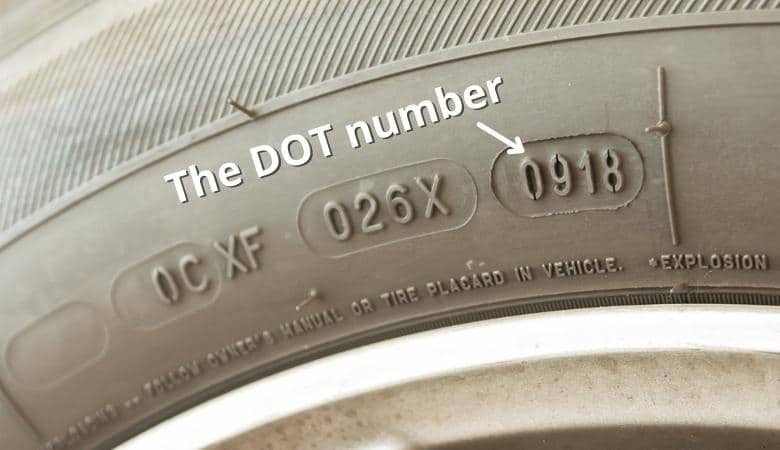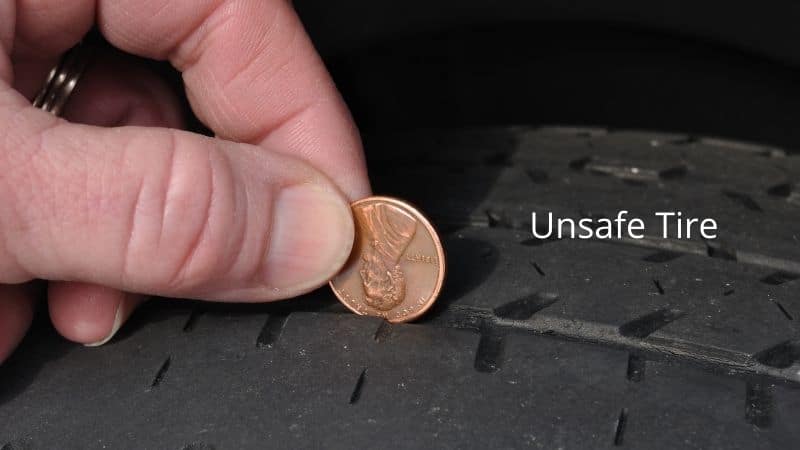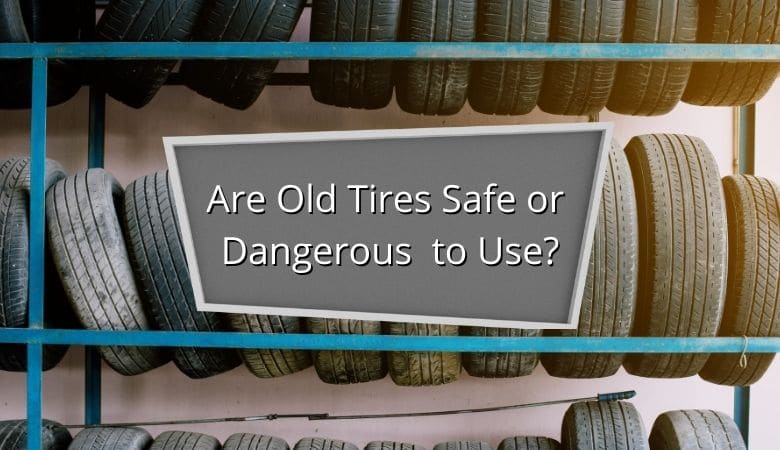Your tires have the greatest effect on the stability of your driving experience, and any substantial degradation in the condition of your tires can compromise your safety.
Protecting yourself and your loved ones starts with understanding the aging process of tires and knowing when to change tires. It’s important to ask important questions, like “are old tires safe to use?”
Old tires are not safe because cracks develop in a tire’s rubber over time, making the tire less safe the older the tire gets. These cracks start to appear on the surface and inside the tire, and will eventually cause the steel belts in the tread to separate from the rest of the tire. A hot climate will also accelerate this aging process.
In this article, you will discover the hazards of using older tires, how to determine tire age, and how to recognize signs that your tires are expiring.
How Are Old Tires Dangerous?
The average American drives 13,476 miles per year, and the tread on your tires will expire within four to five years with regular driving on paved roads. Even if a tire remains unused and appears to be in good condition, it is still unsafe to use if it is more than five years old.
Whether or not you use a tire, degradation will occur. This is because a rubber tire has a limited life span. Since the tire material remains exposed to oxygen, even when it is unused, the particles will become harder and less flexible, causing the internal structure to degrade. Cracks will appear and eventually lead to tire failure.
Nothing can stop the effects of time on rubber, and as the tire ages, the old tire can cause numerous problems, which can be dangerous, these include:
1. Loss of Air Pressure
A major problem with old, worn-out tires is that they lose their much air faster than tires with good tread depth. Under-inflated tires can’t grip the road properly, making it harder to steer. They wear out quicker, and also increase the likelihood of tire punctures.
2. Reduced Grip on the Road
Tread deterioration and hardening of a tire’s rubber reduce a vehicle’s traction on the road surface, as we’ve written more about in this post. This negatively impacts your handling and your ability to brake effectively. A combination of both factors can lead to loss of control while driving.
3. Aquaplaning
As the tread on a tire degrades, its ability to disperse water effectively will decrease. This will increase your chances of aquaplaning when driving in wet conditions.
4. Tire Bursts
Rubber degradation on an older tire causes air to pass through more rapidly. This can cause a tire to burst when traveling at high speeds.
All the problems described above can have fatal consequences for the driver and other motorists. The National Highway and Traffic Safety Administration (NHTSA) reports that there are nearly 11,000 tire-related crashes annually.
A high-profile example is the 2013 accident that killed the actor Paul Walker. The investigation into the cause of the crash revealed that he was riding on nine-year-old tires that could have compromised the effective handling and drivability of the sportscar.
Driving on aging tires, including those that have been left unused for a long time, is dangerous regardless of the outward condition of the tread.
How to Determine the Age of a Tire
The right way to identify how old your tires are is to check the sidewall of the tire. The U.S. Department of Transportation (DOT) requires all tires to have a DOT code, and you just need to know how to decipher it.

On each tire’s sidewall is a Tire Identification Number (TIN) that holds the DOT designation, followed by four digits that state the plant code (with two digits) and the tire size code (also with two digits), followed by three or four digits identifying the brand’s performance specs for the tire, and finally the last three or four numbers that state the DOT code of the tire.
Tires produced after 2000 have a four-digit DOT code. The first two numbers state the week the tire was manufactured, and the second two numbers state the year. For example, a tire with a DOT code of 1120 was produced in the 11th week of the year 2020.
Tires produced before 2000 have an abridged three-digit DOT code. The first two numbers tell you the week of manufacture, and the last number tells you the year of manufacture during that decade. For example, a tire with a DOT code of 118 could be from the 11th week of 1988 or 1978.
The ambiguity in identifying the correct year on tires with the old DOT code made them trickier to decode. However, it is safe to say a tire made in the last century is not safe to use and needs to be replaced.
Checking out the birthdate of your tire is the first step in figuring out whether your tire is no longer safe to use. The next step is to give the tire a visual inspection to check for signs of aging. We will touch more on that later in the article.
Factors That Influence Tire Aging
The NHTSA and tire manufacturers find it difficult to create iron-clad guidelines on tire aging because of the complex range of factors that determine the roadworthiness of a tire.
These factors include heat, storage, and conditions of use. Each of these factors can dramatically reduce the life of a tire.
Here is more on the impact of these factors:
1. Heat
Heat combined with oxygen accelerates rubber aging, causing tires to last a lot less in hotter climates. If you live in a coastal area and other areas with warm weather, you must keep in mind that your tires will fail quicker whether they are ridden or stored.
2. Storage
A tire that is just sitting in your garage or a tire shop will age slowly, but it will age nonetheless. You must keep in mind that this doesn’t apply to a tire that has been mounted on a wheel. A tire that has been mounted on a wheel before being kept in storage will age just as quickly as a tire in service.
3. Conditions of Use
The way a tire is treated will contribute to how quickly or slowly a tire wears out. A tire that has been run into the curb several times, repaired for puncture multiple times, or driven regularly on highways will age differently from a tire on a car that is only driven sparingly.
Many automakers including Nissan, Toyota, and Mercedes-Benz recommend replacing tires six years after their production date, while Tire manufacturers like Michelin say a tire can last up to 10 years provided you get annual inspections after the five-year mark.
Since there is no consensus from the government, carmakers, and tire manufacturers, we will recommend getting your tires inspected after the fifth year regardless of how much tread they have left.
How Do You Know Your Tire Is Expiring?
In the United States, tire tread depth is measured in 32nds of an inch, and safety advocates recommend that a tire should be treated as unusable when the tread depth reaches 2/32 of an inch.
This has led to the popularity of the “penny test”(tread depth measurement with a coin) to determine when to change an old tire.

The idea of the penny test is to place a penny head pointed down between the tread ribs on your tire. If the top of the head disappears between the tread ribs, your tread is still above 2/32 of an inch. If you can still see the entire head of the penny, the tread is below 2/32 of an inch, and it may be time to replace the tire.
However, the penny test can be misleading, since good tread depth does not mean the tire is still in usable condition. There are other more effective ways to spot tire degradation, including:
- Cracks on the tire sidewall
- Distortion of the tire tread
- Uneven tire wear
- Vibrations through the tire that negatively impact ride quality
We recommend replacing your tire immediately if you notice any of the four symptoms listed above.
How Can You Avoid Aging Tires?
Here are a few tips to help you stay clear of aging tires:
1. Avoid Buying Used Tires
Even though tires are expensive, you are better off buying new tires. They always prove to be a longer and safer investment when compared to used tires. Even if a used tire is only a couple of years old, you have no idea how well it was maintained and the conditions in which it was used.
2. Always Ensure Your New Tire Is Truly “Fresh”
One of the most important things to do before purchasing tires at retail stores is to check the date before you buy. A tire on sale may be past its warranty period or a few years old. Such a tire will have a shorter life on the road and be more expensive to maintain.
3. Let go of Aged Spare Tires
Spare tires are designed to aid you for a short period of time and driving with a 7+-year-old spare tire can be very dangerous. We recommend replacing your spare tire anytime you purchase a new set of tires for your vehicle.
Conclusion
The bottom line is that tires get worse as they age, and ignoring aging signs on your tires can place you and other road users at great risk.
The best practice is to have your tires inspected by professionals after the five-year mark, and continue the inspection annually until the tires are declared unusable.
Hi, my name is Niklas, the head content creator & CEO of Whirling Wheelz. I am very interested in vehicles of all kinds, mainly cars. I have a car mechanics degree from high school and a big hobby of mine is to follow the WRC (World Rally Championship) both online and through travel.


